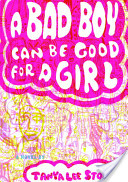Of the top ten books that landed a spot on the American Library Association’s “Most Frequently Challenged” list for 2013, seven got there because someone considered them sexually explicit.
About this time a couple of years ago, I wrote about one of the novels that’s been on the list ever since its publication–“Fifty Shades of Grey” by E.L. James. I consider it dreadful for a number of reasons, including the fact that the writing is terrible and the sex gratuitous, but I’m perfectly okay with the book being available for adult readers who wish to waste time with such tripe. I’m certain, however, that no teacher or school librarian would include “Fifty Shades” as part of the curriculum, so I’m a little puzzled that it made it onto the ALA list.
But I’m not surprised that “A Bad Boy Can Be Good for a Girl” by Tanya Lee Stone did.
Published in 2006, Stone’s debut novel is written in free verse. It tells the story of three high school girls who fall for the same bad boy—stereotypically, a good-looking senior who plays on both the varsity baseball and football teams. He’s referred to in the book only by the initials “T.L.” His method of operation? Convince a girl he’s madly in love with her until she gives in to his sexual demands. Then break up with her after spreading the word, in intimate detail, about what the two of them have done together.
Josie, the novel’s first narrator, is a freshman who figures out what’s going on just in the nick of time. (The fact that she heard some of T.L.’s friends refer to her as “fresh meat” helped speed that process along.) To warn others about T.L., Josie becomes the fearless ringleader of an ever-increasing group of girls who write about their negative experiences with him on the blank back pages of the school library copy of “Forever” by Judy Blume.
Not all of T.L.’s intended conquests escape as unscathed as Josie. Nicolette, a loner being raised by a single mom who’s something of a party girl herself, gives in to T.L’s charms as is soon known as the school slut. Aviva, a child of free-spirited parents who trust her judgment a little too much, also succumbs. So do a whole lot of other girls, many of whom find a measure of solace by writing about T.L. in the back of the Judy Blume book.
The most poignant entry? “I hope I remember these feelings forever: stupid, humiliated, foolish, stung, heartbroken, and a little bit wiser. I hope I remember so I never fall for this kind of boy again.”
This book is not for middle school readers. Descriptions of what T.L. does to his victims, both physically and emotionally, are frank and squirm-inducing. But I can’t help but believe that any freshman girl who reads this book at the beginning of high school, especially under the guidance of a caring adult, might save herself a lot of grief. It’s a cautionary tale that couldn’t have been told without its strong sexual content. As the author herself said, in defense of the novel, “a book is an incredibly safe place to walk in someone else’s shoes without taking risks yourself.”
So yes, I understand how “A Bad Boy Can Be Good for a Girl” landed on the banned book lists. And I applaud the courage of any parent, teacher or school librarian who is brave enough to recommend it.
By the way, “T.L.” stands for “The Loser.”
(September 21, 2014)
